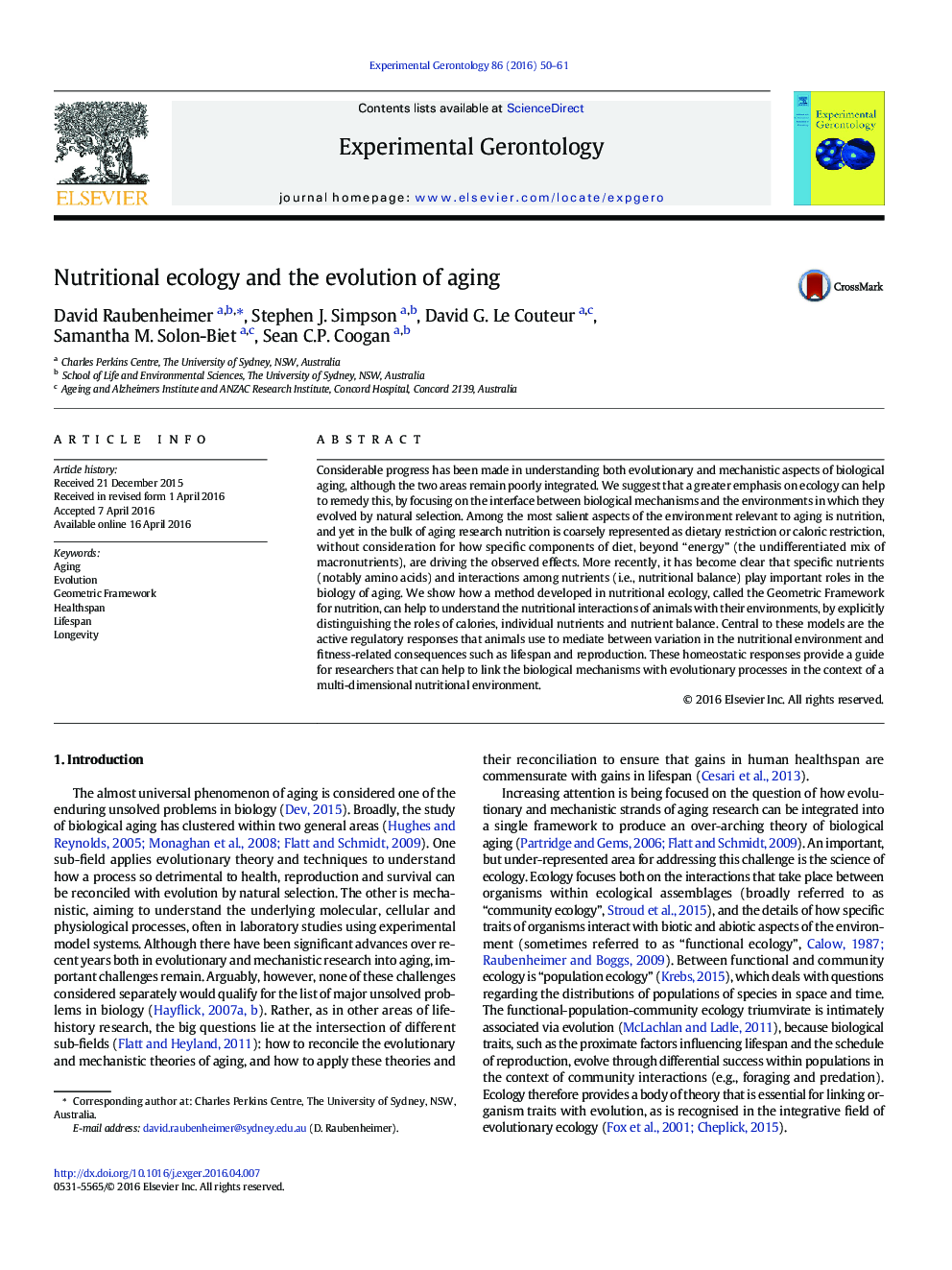| کد مقاله | کد نشریه | سال انتشار | مقاله انگلیسی | نسخه تمام متن |
|---|---|---|---|---|
| 5501507 | 1534855 | 2016 | 12 صفحه PDF | دانلود رایگان |
عنوان انگلیسی مقاله ISI
Nutritional ecology and the evolution of aging
ترجمه فارسی عنوان
محیط زیست تغذیه و تکامل پیری
دانلود مقاله + سفارش ترجمه
دانلود مقاله ISI انگلیسی
رایگان برای ایرانیان
کلمات کلیدی
سالخورده، سیر تکاملی، چارچوب هندسی سلامتی، طول عمر، طول عمر،
ترجمه چکیده
پیشرفت قابل ملاحظه ای در درک جنبه های تکاملی و مکانیکی پیری بیولوژیکی صورت گرفته است، هرچند دو حوزه به طور ضعیف یکپارچه باقی مانده اند. ما پیشنهاد می کنیم که تمرکز بر روی رابط بین مکانیسم های بیولوژیکی و محیط هایی که در آن با انتخاب طبیعی تکامل یافته است، تاکید بیشتری بر بوم شناسی می تواند به بهبود آن کمک کند. در میان مهم ترین جنبه های محیط زیست مربوط به پیری، تغذیه است و در عین حال در تحقیقات پیرامونی تغذیه به طور محدود به عنوان محدودیت غذایی یا محدودیت کالری، بدون در نظر گرفتن چگونگی اجزای خاص رژیم غذایی، فراتر از انرژی؟ (ترکیبی غیرمتعارف مغذی ها)، اثرات مشاهده شده را رانندگی می کنند. اخیرا روشن شده است که مواد مغذی خاص (به ویژه اسیدهای آمینه) و تعاملات میان مواد مغذی (به عنوان مثال، تعادل تغذیه ای) نقش مهمی در زیست شناسی پیری بازی می کنند. ما نشان می دهیم که چگونه یک روش توسعه یافته در محیط زیست تغذیه، به نام چارچوب هندسی برای تغذیه، می تواند به درک متابولیسم های تغذیه حیوانات با محیط آنها، با صراحت نقش کالری، مواد مغذی فردی و تعادل مواد مغذی را مشخص کند. مرکزی برای این مدل ها واکنش های قانونی فعالانه ای است که حیوانات از بین می برند بین تغییرات در محیط تغذیه ای و عواقب مرتبط با تناسب اندام مانند طول عمر و تولید مثل. این پاسخهای هوموستازی پاسخگوی راهنمایی برای محققانی است که می توانند به برقراری ارتباط مکانیسم های بیولوژیکی با فرآیندهای تکاملی در زمینه محیط تغذیه چند بعدی کمک کنند.
موضوعات مرتبط
علوم زیستی و بیوفناوری
بیوشیمی، ژنتیک و زیست شناسی مولکولی
سالمندی
چکیده انگلیسی
Considerable progress has been made in understanding both evolutionary and mechanistic aspects of biological aging, although the two areas remain poorly integrated. We suggest that a greater emphasis on ecology can help to remedy this, by focusing on the interface between biological mechanisms and the environments in which they evolved by natural selection. Among the most salient aspects of the environment relevant to aging is nutrition, and yet in the bulk of aging research nutrition is coarsely represented as dietary restriction or caloric restriction, without consideration for how specific components of diet, beyond “energy” (the undifferentiated mix of macronutrients), are driving the observed effects. More recently, it has become clear that specific nutrients (notably amino acids) and interactions among nutrients (i.e., nutritional balance) play important roles in the biology of aging. We show how a method developed in nutritional ecology, called the Geometric Framework for nutrition, can help to understand the nutritional interactions of animals with their environments, by explicitly distinguishing the roles of calories, individual nutrients and nutrient balance. Central to these models are the active regulatory responses that animals use to mediate between variation in the nutritional environment and fitness-related consequences such as lifespan and reproduction. These homeostatic responses provide a guide for researchers that can help to link the biological mechanisms with evolutionary processes in the context of a multi-dimensional nutritional environment.
ناشر
Database: Elsevier - ScienceDirect (ساینس دایرکت)
Journal: Experimental Gerontology - Volume 86, 15 December 2016, Pages 50-61
Journal: Experimental Gerontology - Volume 86, 15 December 2016, Pages 50-61
نویسندگان
David Raubenheimer, Stephen J. Simpson, David G. Le Couteur, Samantha M. Solon-Biet, Sean C.P. Coogan,
